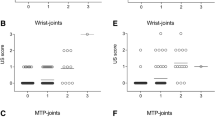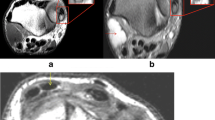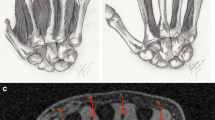Abstract
Objective. To evaluate the distribution and extent of wrist tendon alterations in patients with active rheumatoid arthritis (RA) using magnetic resonance imaging (MRI).
Design and patients. Forty-three clinically active RA patients with an illness duration of less than 4 years and no clinical evidence of tendons tears were enrolled in the study. There were 10 men and 33 women, with an average age of 52 years (range 33– 63 years). MRI of both wrists, with one exception, was performed at 1.0 T using T1- and T2-weighted sequences (slice thickness 3 mm). Twelve healthy subjects (8 women, 4 men; mean age 31 years) were also evaluated as a control group. Two radiologists reviewed each of four schematic anatomical regions (volar, dorsal, ulnar, radial) for the degree of tendon and tendon sheath alterations using two progressive scales.
Results. In the control group all tendons had homogeneous low signal intensity on all sequences. A small amount of fluid was found in six subjects but the diameter was always less than 1 mm. In the patient group minimal fluid (<2 mm) was found in 35 (41%) wrists, grade 2 fluid (<2>5 mm) in 26 (31%) and grade 3 fluid (>5 mm) in 24 (28%). Fifty-nine (69%) of the grade 1 changes were in the volar compartment but grade 2 involvement was evenly distributed. Grade 3 changes were most common in the dorsal compartment and combined grade 2 and 3 in the dorsal and ulnar compartments were 32 (38%) and 25 (30%) compared with 16 (18%) and 17 (20%) respectively in the volar and radial compartments. The tendons were normal (grade 0) in 47 (46%) wrists. A maximum tendon signal change (grade 1) was demonstrated in 28 wrists (32%). When associated with other individual tendons grades this grade was demonstrated in the dorsal compartment in 30 (35%) wrists, in the volar compartment in 12 (14%), in the radial compartment in 17 (20%) and in the ulnar compartment in 26 (30%). A partial tear (grade 2) was detected in 7 (8%) wrists, all involving the dorsal and ulnar compartments; five underwent surgical repair and one proved to have a complete rupture of extensor digitorum. Three (3%) had a grade 3 complete tendon tear: all of these were in extensor tendons. Surgical repair was successful in one case but two ruptured again within 3 months.
Conclusions. Low grades of peritendinous effusion were more common in the volar compartment whereas moderate and high degrees of tendon sheath fluid collection and/or pannus and signs of tendonitis were more frequent in the dorsal and ulnar tendon sheaths.
Similar content being viewed by others
Author information
Authors and Affiliations
Additional information
Received: 20 January 2000 Revision requested: 24 February 2000 Revision received: 25 October 2000 Accepted: 19 December 2000
Rights and permissions
About this article
Cite this article
Valeri, G., Ferrara, C., Ercolani, P. et al. Tendon involvement in rheumatoid arthritis of the wrist: MRI findings. Skeletal Radiol 30, 138–143 (2001). https://doi.org/10.1007/s002560100322
Issue Date:
DOI: https://doi.org/10.1007/s002560100322




